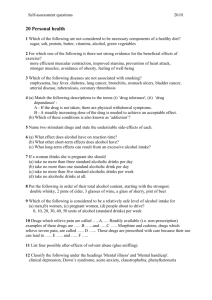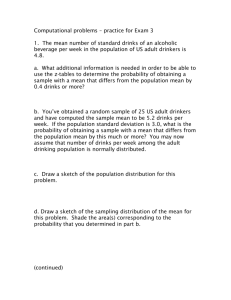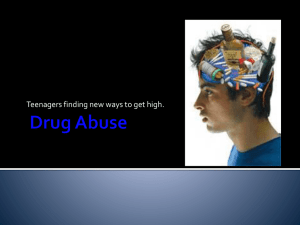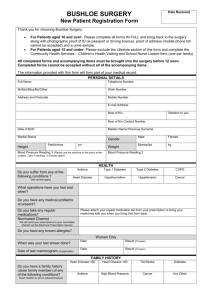Alcohol, Energy Drinks, and Youth: A Dangerous Mix
advertisement
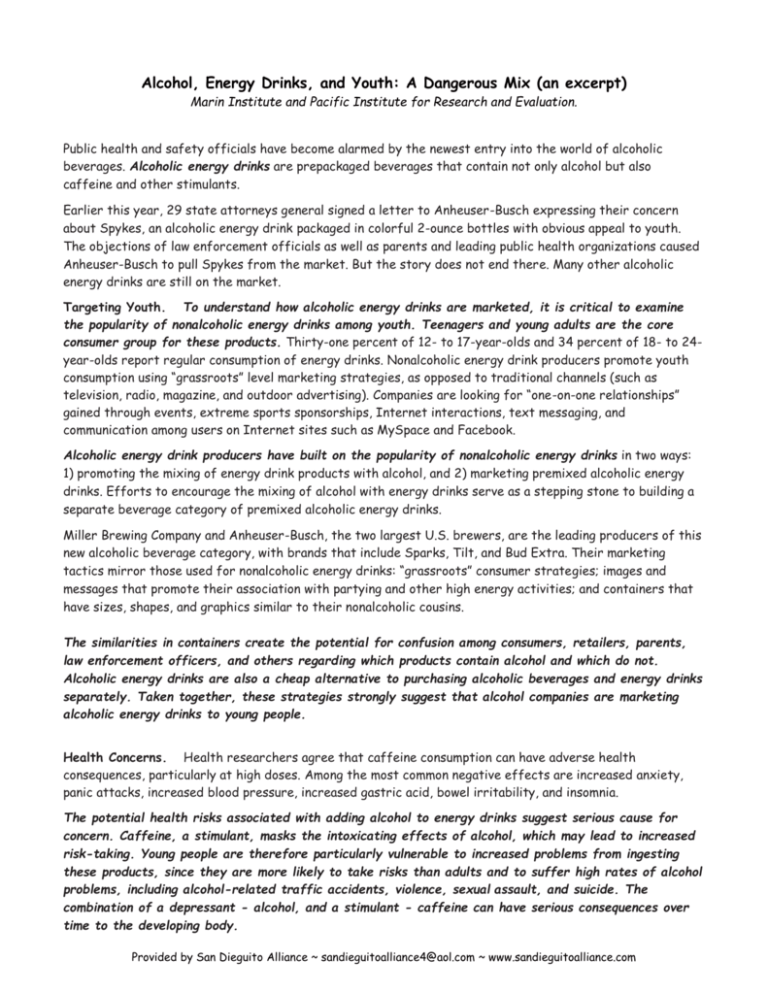
Alcohol, Energy Drinks, and Youth: A Dangerous Mix (an excerpt) Marin Institute and Pacific Institute for Research and Evaluation. Public health and safety officials have become alarmed by the newest entry into the world of alcoholic beverages. Alcoholic energy drinks are prepackaged beverages that contain not only alcohol but also caffeine and other stimulants. Earlier this year, 29 state attorneys general signed a letter to Anheuser-Busch expressing their concern about Spykes, an alcoholic energy drink packaged in colorful 2-ounce bottles with obvious appeal to youth. The objections of law enforcement officials as well as parents and leading public health organizations caused Anheuser-Busch to pull Spykes from the market. But the story does not end there. Many other alcoholic energy drinks are still on the market. Targeting Youth. To understand how alcoholic energy drinks are marketed, it is critical to examine the popularity of nonalcoholic energy drinks among youth. Teenagers and young adults are the core consumer group for these products. Thirty-one percent of 12- to 17-year-olds and 34 percent of 18- to 24year-olds report regular consumption of energy drinks. Nonalcoholic energy drink producers promote youth consumption using “grassroots” level marketing strategies, as opposed to traditional channels (such as television, radio, magazine, and outdoor advertising). Companies are looking for “one-on-one relationships” gained through events, extreme sports sponsorships, Internet interactions, text messaging, and communication among users on Internet sites such as MySpace and Facebook. Alcoholic energy drink producers have built on the popularity of nonalcoholic energy drinks in two ways: 1) promoting the mixing of energy drink products with alcohol, and 2) marketing premixed alcoholic energy drinks. Efforts to encourage the mixing of alcohol with energy drinks serve as a stepping stone to building a separate beverage category of premixed alcoholic energy drinks. Miller Brewing Company and Anheuser-Busch, the two largest U.S. brewers, are the leading producers of this new alcoholic beverage category, with brands that include Sparks, Tilt, and Bud Extra. Their marketing tactics mirror those used for nonalcoholic energy drinks: “grassroots” consumer strategies; images and messages that promote their association with partying and other high energy activities; and containers that have sizes, shapes, and graphics similar to their nonalcoholic cousins. The similarities in containers create the potential for confusion among consumers, retailers, parents, law enforcement officers, and others regarding which products contain alcohol and which do not. Alcoholic energy drinks are also a cheap alternative to purchasing alcoholic beverages and energy drinks separately. Taken together, these strategies strongly suggest that alcohol companies are marketing alcoholic energy drinks to young people. Health Concerns. Health researchers agree that caffeine consumption can have adverse health consequences, particularly at high doses. Among the most common negative effects are increased anxiety, panic attacks, increased blood pressure, increased gastric acid, bowel irritability, and insomnia. The potential health risks associated with adding alcohol to energy drinks suggest serious cause for concern. Caffeine, a stimulant, masks the intoxicating effects of alcohol, which may lead to increased risk-taking. Young people are therefore particularly vulnerable to increased problems from ingesting these products, since they are more likely to take risks than adults and to suffer high rates of alcohol problems, including alcohol-related traffic accidents, violence, sexual assault, and suicide. The combination of a depressant - alcohol, and a stimulant - caffeine can have serious consequences over time to the developing body. Provided by San Dieguito Alliance ~ sandieguitoalliance4@aol.com ~ www.sandieguitoalliance.com
